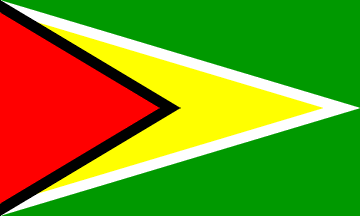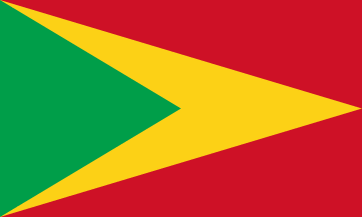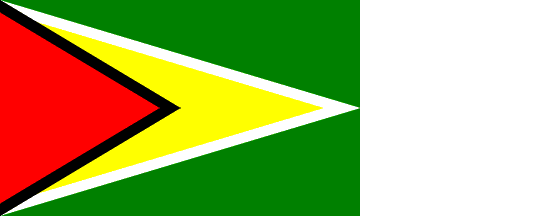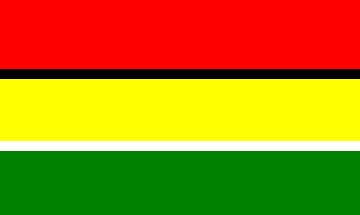
image by Željko Heimer, 27 October 2001

Last modified: 2014-04-16 by zoltán horváth
Keywords: guyana | america | arrow |
Links: FOTW homepage |
search |
disclaimer and copyright |
write us |
mirrors

image by Željko Heimer, 27 October 2001
Official Name: Co-operative Republic of
Guyana
Previous Name: British Guiana
Capital: Georgetown
Location: South America
Government Type: Republic within the
Commonwealth
Flag adopted: 1966
Author: Whitney Smith
Coat of Arms adopted: 1966
ISO Code: GY
See also:
From <www.guyana.org>:
"The Golden Arrowhead, Guyana's National Flag has FIVE
symbolic colors:
GREEN represents the agricultural and forested nature of
Guyana,
WHITE symbolizes the rivers and water potential of the
country,
GOLDEN arrow represents Guyana's mineral wealth,
BLACK portrays the endurance that will sustain the forward
thrust of the Guyanese people,
RED represents the zeal and dynamic nature of nation-building
which lies before the young and independent Guyana."
Dov Gutterman, 6 January 1999
At July York ICV meeting, showing Guyana page of Album to
Whitney Smith, he told me that my ill. 1 (sea version) is wrong,
summit of triangle should reach the middle of flag.
Armand du Payrat, 25 October 2001
According to Album 2000 [pay00]
- National Flag (CSW/--- 3:5) - On lnad the flag is in ratio 3:5,
green with white fimbrated yellow isosceles triangle with base at
hoist and top at fly end, and over it a black fimbrated red
traingle with bas at hoist and top at midpoint of the flag. The
fimbrations are not made along hoist edge, of course.
Apparently, as Armand discovered talking with Whitney Smith, the
hoist trinagle should reach the midpoint of the flag (and should
not be an equilateral triangle).
Željko Heimer, 27 October 2001
Although I have no correct construction sheet of the Guyana
flag, I've found an interesting data in Ludvik Mucha's book
"Flags and Coats of Arms". According to him, green
color occupies 50% of the flag area, yellow 24%, red 16%, white
6% and black 4%. However, if the red+black triangle reaches the
center of the flag, red+black should occupy 25% (not 20%), and
yellow+white also 25% (not 30%) of the area.
Jan Zrzavy, 7 November 2001
I find the document at <www.parliament.gov.gy>
which sets out the construction sheet. However, it looks really
useless since it provides no drawing or any sort of hint. All it
says is the green is 50", gold 24", white 67" and
the black is 1".
However, it is worth noting that this document confirms the civil
ensign to be in a 1x2 ratio.
Zachary Harden, 27 November 2009
My own spec. for this flag is exactly based upon one by the
late William Crampton, which was in turn taken from the brochure
"Symbols of Nationhood" published on the day of
independence (26 May 1966). I have seen the brochure in the Flag
Institute files but unfortunately failed to take a copy.
William Crampton's specs shows the white pile to be (of course)
the length of the flag whilst the apex of the black triangle
touches the exact centre. In order to show the sizes
of the red and yellow triangles, the spec. gives the white and
black as fimbriations equal to 3/50 the width of the flag.
My memory (such as it is) tells me that these specs are accurate
to the brochure, but I don't have a copy to confirm.
Christopher Southworth, 28 November 2009

image by Kazutaka Nishiura, 03 March 2014
This is probably the only current national flag to be designed
by Whitney Smith and his team!
David Kendall, 1 October 1996
The black and white fimbriations were not in Whitney Smith's
original design, but were added by the English College of Arms.
Can't see why, as the flag wasn't disobeying the
colour-on-colour/metal-on-metal rule before (it does now!).
Roy Stilling, 1 October 1996 and 14 May 1997
The current flag of Guyana was designed in 1962 by an
American, Mr. Whitney Smith, and was the result of an
international competition held by the then government. (The year
1962 was expected to be "Independence Year"). The
design was NEVER CHANGED by the new government which took office
in December 1964. This flag of Guyana, since 1966, became known
as the "Golden Arrowhead."
Amb. Odeen Ishmael, Guyana Embassy - Washington DC, 18
December 2000
In DK's Complete Flags of the World (1999) [udk99] I read: 'The original design
had a red field, but this was altered by the College of Arms (in
England) in 1966, which also added the black and white
fimbriations.' That is corroborated in Crampton's FOTW (1990) [cra90i] and by Roy Stilling.
Jarig Bakker, 18 December 2000
Just a clarification: "The original design had a red
field" - I assume it means: 'green triangle on yellow arrow
on red field' and not 'red triangle on yellow arrow on red
field'.
Ole Andersen, 18 December 2000
In Smith's original design, the red and the green altered
their positions. I believe that it was because that those who
participate in a contest want to win the contest. Smith made his
design prevaling the red color according to the leftist
inclinations of the premier Mr. Jagan (a ethnic indian
pro-soviet). The design of Vaclav Kalikova also show a gold
triangle (but single) from hoist to fly and rest is green (and a
blue star is in the yellow triangle). Perhaps the College of arms
made a mixture of both designs. I believe that the five colors
were in fact requested by the government (I read it) but I don't
remember if for Mr. Jagan or Mr. Burham. The fimbriations are
against the heraldic principes and is strange that College of
arms (aleways precise) added unnecesary fimbriations.
Jaume Ollé, 7 January 2001
1) 
image by André Pires Godinho, 1 June 2003
2) 
image by André Pires Godinho, 1 June 2003
I saw a picture of Georgetown in the day of the independence
of Guyana, in this picture is showed two flags, I don't know if
these flags are still in use, but these flags are a more used in
this comemoration than the national one.
The first is the national flag with a extension in white, the
size of the extension is aproximaly 1/2 of the national flag
The second is a flag with three horizontal stripes in the colors
red, yellow and green with black and white fimbriations between
the stripes.
So this is the ask...someone know the use or the meaning of these
flags?
André Pires Godinho, 1 June 2003
As to the second: My guess is that it is an inexpensive,
easily sewn celebratory flag which displays the national colors.
The arrowhead design is striking, but not easily stitched at
home. People without a copy of the national flag might have
elected to create the horizontal design which is easy to assemble
with a sewing machine.
Al Kirsch, 1 June 2003
The protocol manual for the
London 2012 Olympics
(Flags and Anthems Manual
London 2012 [loc12]) provides recommendations
for national flag designs. Each
NOC
was sent an image of the flag, including the
PMS shades, for their approval by LOCOG. Once this was obtained, LOCOG produced
a 60 x 90 cm version of the flag for further approval. So, while these specs may
not be the official, government, version of each flag, they are certainly what
the NOC
believed the flag to be.
For Guyana: PMS 032 red, 109 yellow, 355 green and black. The vertical flag is
simply the horizontal version turned 90 degrees clockwise.
Ian Sumner, 10 October 2012
The Guyana National Pledge, as reproduced on the TUF website,
mentions the national flag (in the first position):
"I pledge myself to honour always the flag of Guyana, and to
be loyal to my country, to be obedient to the laws of Guyana, to
love my fellow citizens, and to dedicate my energies towards the
happiness and prosperity of Guyana."
Ivan Sache, 29 September, 2007
Guyana is divided to ten regions: Barima-Waini,
Cuyuni-Mazaruni, Demerara-Mahaica, East Berbice-Corentyne,
Essequibo Islands-West Demerara, Mahaica-Berbice,
Pomeroon-Supenaam, Potaro-Siparuni, Upper Demerara-Berbice, Upper
Takutu-Upper Essequibo.
There is no information about flags used by subdivisions.
Dov Gutterman, 8 August 2004